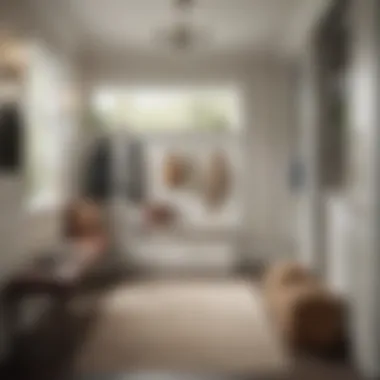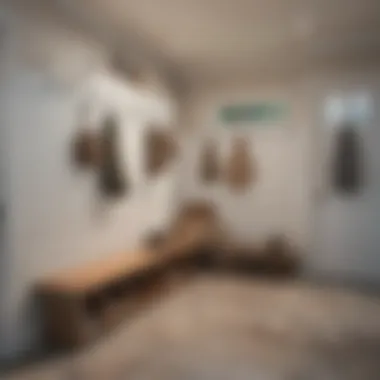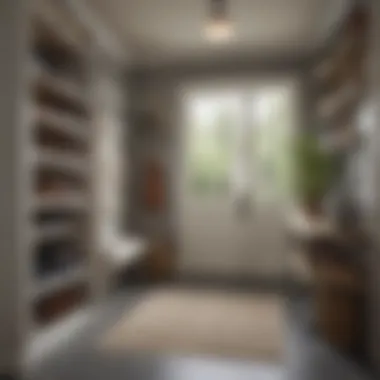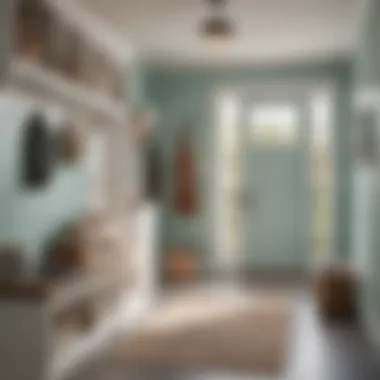Innovative Mudroom Designs for Stylish Entryways


Intro
The entryway of a home is more than just a passage. It is the initial impression that greets visitors and reflects the homeowner's style and functionality. Among the various areas in a home, the mudroom often serves as a vital space that combines convenience and aesthetic appeal. Given its purpose as a transitional space, mudrooms can become cluttered quickly. Therefore, an innovative design can transform this functional area into an organized and inviting entryway.
This article will delve into a range of custom mudroom ideas encompassing design inspiration, storage solutions, and decorative elements that enhance both style and utility. Homeowners seeking to optimize their mudroom experience will find practical suggestions and detailed insights here.
Design Inspiration
Design inspiration is crucial when tailoring a mudroom that meets practical needs while being visually pleasing. The right choices can elevate the mudroom from a mere utility space to a beautiful entry that welcomes guests with charisma.
Trending Styles and Themes
Some trending styles resonating with modern homeowners include:
- Minimalist: This style emphasizes simplicity, incorporating clean lines and functional elements. The use of natural materials and neutral colors fosters a serene atmosphere.
- Farmhouse: Draws from rustic elements and traditional designs. Features such as shiplap walls, barn doors, and vintage accents create warmth and charm.
- Industrial: Combining metal, wood, and concrete, this style brings an urban edge. Open shelving and exposed pipes are common elements, contributing to a rugged aesthetic.
- Coastal: Evokes a relaxed vibe, utilizing soft colors and natural materials. Nautical accessories can enhance this theme, creating a breezy feel.
Choosing a style that reflects personal preference is essential. It not only enhances the mudroom's aesthetic but also ensures that the space feels comfortable and welcoming.
Color Palettes and Combinations
Colors play a significant role in defining the atmosphere of a mudroom. Here are some effective color combinations to consider:
- Soft Neutrals: Shades like beige, taupe, and soft gray can make the area feel more spacious. These colors serve as a versatile backdrop for various decorative elements.
- Bold Accents: Consider incorporating a splash of color with accent walls or accessories in bold shades like navy blue or forest green. Such accents can provide focal points.
- Natural Tones: Colors derived from nature, such as earthy greens or warm browns, can contribute to a more inviting environment while complementing natural materials.
When selecting colors, think about the overall ambiance you wish to create in the mudroom. The combination of walls, storage units, and decor should harmonize to foster an inviting entryway.
"A well-designed mudroom can seamlessly blend functionality with style, leaving a lasting impression on everyone who enters your home."
Understanding Mudrooms: A Comprehensive Overview
When considering the functionality of a home, the mudroom stands out as a crucial space. This area serves as the transition between the outdoors and the indoors. It is often the first point of contact for guests and family members coming into the house. Mudrooms offer practical benefits such as keeping dirt and moisture outside where they belong. They also provide a dedicated space for organizing everyday items such as shoes, coats, and bags. The need for an entryway that enhances both functionality and organization has never been clearer, especially for busy households.
The Purpose of a Mudroom
The fundamental purpose of a mudroom is to serve as a practical and organized entry point for a home. This space addresses several needs:
- Minimizing Clutter: A mudroom acts as a buffer zone, reducing the amount of dirt and debris that may come from outside. By providing storage for shoes and jackets, it minimizes the clutter that can invade the rest of the house.
- Organizing Essentials: In busy homes, organization is key. A well-planned mudroom can house everything from footwear to outdoor gear. Its layout allows for personalized storage solutions that fit each family's distinctive routine.
- Protection of Interior Spaces: Homes often face wear and tear from outdoor elements. A designated muddy space helps protect floors and other interior spaces from the conditions of the outside world.
Historical Evolution of Mudrooms
Mudrooms have evolved significantly over the years, stemming from practical needs throughout history. Their origins can be traced back to when homes did not have sufficient insulation. Here are some notable evolutionary points:
- Early Homes: In older homes, a simple entryway served as a place to change from outdoor to indoor attire. It was often a basic structure, lacking defined features.
- Industrial Age: With urbanization, homes became more structured, and mudrooms began to take form as separate areas to contain mess and clutter.
- Modern Design: Today, mudrooms are regarded as integral parts of home design. They mix functionality with aesthetics. Modern designs often include built-in storage, seating, and creative features, preserving both the utility and beauty of the space.
Mudrooms blend function with design, historically adapting to the changing needs of homeowners.
Essential Components of a Custom Mudroom
A well-designed mudroom serves as a practical transition space between the home and the outside world. It functions not only as an entryway but also as a storage area for various belongings that might otherwise clutter the house. The essential components of a custom mudroom can significantly enhance its usability, transforming this space into a functional area tailored to the homeowner's specific needs and lifestyle.
Functional Furniture Choices


Selecting the right furniture for your mudroom is crucial. Functional pieces should balance style and utility. A bench for seating can provide a comfortable area for putting on or taking off shoes, while also serving as a storage compartment. For instance, a bench with built-in drawers keeps out-of-season shoes or accessories neatly tucked away.
Another important piece is a versatile table or shelf, ideal for setting down keys, mail, or bags. Simple designs can reduce visual clutter and allow for easy access. When assessing the space, consider the proportions of the furniture. Items should not obstruct movement, and every piece should have a purpose. Modular furniture systems that can be adapted over time may also be a wise consideration, catering to changing family needs.
Storage Solutions for Busy Families
In a busy household, adequate storage solutions are paramount. Cubbies or cubical storage can be highly effective in organizing items such as shoes, coats, and backpacks. Each family member can have their assigned space, which minimizes chaos and promotes accountability.
Additionally, wall-mounted shelves can maximize vertical space while keeping frequently used items reachable. Consider the inclusion of clear baskets or labeled boxes to simplify locating items. Following a systematic approach to storage—placing heavier items lower and lighter items higher—can enhance both accessibility and safety in the mudroom environment.
Innovative Flooring Materials
The choice of flooring in a mudroom directly impacts both aesthetics and functionality. Durable and easy-to-clean materials are often preferred in high-traffic areas. For instance, luxury vinyl tiles offer a variety of designs while resisting moisture and stains. They can emulate the look of wood or stone without the upkeep involved.
Ceramic tiles also present a sturdy option, allowing for intricate designs that can complement your mudroom’s theme. Moreover, rubber flooring is an underutilized material. It provides slip resistance, absorbs impact, and can be easily cleaned, making it suitable for families with pets or active children. Opting for tiles or flooring that can withstand outdoor elements will prolong the longevity of your investment.
"A well-planned mudroom is not only about style but about the efficiency it brings to daily routines."
By addressing these essential components of a custom mudroom, homeowners can ensure that their entryway is both functional and stylish, effectively organizing their daily lives.
Design Ideas for Custom Mudrooms
Designing a custom mudroom is not just about creating a functional space; it is about establishing an entryway that complements the home’s overall aesthetic. An effectively designed mudroom serves as a transition zone, bridging the outside world and the interior of the home. Configuration and stylistic choices greatly influence not only the look of the room but also its purpose. The right design can facilitate better organization, improve traffic flow, and even enhance the ambiance of the home.
Custom mudroom ideas should focus on personal needs, considering factors like family size, lifestyle, and storage requirements. A well-organized mudroom can keep the rest of the house tidy by managing clutter at the entrance. Moreover, incorporating visually appealing elements allows homeowners to express their tastes from the moment they enter their home.
Minimalist Mudroom Concepts
Adopting a minimalist approach to mudroom design emphasizes simplicity and functionality. The essence of minimalism is to only include what is necessary. Here, form meets function. The goal is to create a clean and open space without overwhelming details.
- Designature Elements: Use a neutral color palette with subtle textures. Soft greys or whites help in promoting brightness and airiness.
- Essential Furniture: Consider functional furniture like a simple bench or a narrow console table, which can serve multiple purposes like dropping keys or bags.
- Efficient Storage: Utilize wall-mounted shelves to keep the floor clear for easier movement. Consider also integrating hidden storage solutions.
Rustic Charm: Embracing Natural Materials
For those who appreciate warmth and earthiness, rustic design can be an ideal option for a custom mudroom. This concept utilizes natural materials and textures, creating a homey feel.
- Materials: Wood is a primary choice here. Exposed beams, reclaimed wood for benches, and oak cabinetry can provide that rustic touch.
- Color Palette: Earth tones like browns, greens, and deep reds evoke a cozy vibe that complements natural elements.
- Decorative Touch: Incorporate decorative items such as vintage hooks or wrought-iron accents. These can serve practical purposes while adding character to the space.
Modern Aesthetic: Sleek Lines and Contemporary Colors
In contrast to rustic charm, the modern aesthetic focuses on sleek designs and the use of bold, contemporary colors. This style attracts those who prefer a more polished look in their mudroom.
- Clean Lines: Opt for cabinetry with straightforward shapes devoid of ornamentation for an uncluttered appearance. Favor flat-panel doors and geometric shelving for a modern feel.
- Color Choices: Utilize sharp contrasts such as black and white or bright pops of color, like teal or mustard, against a subdued backdrop.
- Technology Integration: Consider integrating smart storage solutions such as charging stations or motion-sensor lighting.
In designing a custom mudroom, remember that why it is created can be just as vital as how it is created. The blend of style and function transforms an ordinary entryway into an extraordinary one.
Incorporating Functional Features
In the design of any mudroom, the inclusion of functional features is paramount. These elements cater to the unique needs of the household, ensuring that the space remains organized and practical. Homeowners often overlook how certain features can transform a mudroom into a highly efficient area that supports daily routines. Therefore, considering the layout and accessories becomes crucial.
Built-in Benches and Seating Options


Built-in benches are a popular choice for mudrooms because they offer a dedicated place to sit while putting on or removing shoes. This simple feature greatly enhances convenience. They can be designed to match the overall aesthetic of the home, using materials like wood or metal for durability. Adding cushions can provide comfort, making the mudroom not just functional but also inviting. Sometimes, these benches have storage underneath, providing space for shoes or other items.
- Ergonomic Design: A well-designed bench allows for ease of use.
- Storage Solutions: They can double as storage spaces, maximizing utility.
- Aesthetic Appeal: They can be customized to fit personal style.
Cubbies and Baskets for Organization
Cubbies and baskets are vital for maintaining order in a mudroom. They serve as designated spots for various items, such as hats, gloves, and bags. When each item has its own space, it reduces clutter. This feature can be particularly important for families with children, as it encourages organization from an early age.
- Variety of Sizes: Cubbies come in different sizes, accommodating various items for all ages.
- Color Coordination: Using colors can help in identifying designated spaces easily.
- Customizable Options: Homeowners can design cubbies to fit their needs and available space.
Hooks and Railing Systems for Utility
Hooks and railing systems are indispensable in a mudroom. They provide an immediate and accessible way to hang up coats, bags, and umbrellas. Installing these features allows for efficient use of vertical space, which is often underutilized. Homeowners can choose from various styles, such as rustic wood hooks or sleek metal designs, aligning with the mudroom's overall theme.
"A well-organized mudroom not only helps to reduce chaos but also adds to the overall functionality of a home."
When considering hooks, it's essential to keep future needs in mind. The number of hooks should match the household's requirements, taking into account the seasons when heavier outerwear is needed. Additionally, higher hooks can be useful for hanging larger items, while lower hooks can help children reach their belongings easily.
By integrating these functional features into a mudroom, homeowners can create a versatile space that promotes organization and enhances daily routines. Understanding the significance of each aspect—for instance, seating arrangements, storage options, and hanging systems—can lead to a harmonious and efficient entryway.
Personalizing Your Mudroom Experience
Personalizing your mudroom is essential for homeowners who desire both functionality and style. The mudroom serves as that critical transition space between the indoors and outdoors. Its design should not only cater to storage solutions but also reflect personal tastes and lifestyle choices. Taking time to curate this space enhances its utility and promotes a welcoming atmosphere. Plus, when a mudroom is tailored to your needs, it makes daily routines more efficient.
By considering various elements like color schemes and decorative choices, one can create an entryway that feels distinctly their own. Additionally, personalization can improve how the space functions. For instance, the use of specific furnishings that suit your habits can drastically change how the area operates. Therefore, integrating personal touches is not simply about aesthetics; it is about establishing a functional environment that aligns with your lifestyle.
Color Schemes that Reflect Your Style
Choosing the right color scheme is key to personalizing your mudroom experience. Color affects mood and perception, which is why the palette you select can significantly influence how the entire space feels. A well-thought-out color choice can invigorate the room or create a calming atmosphere, depending on your preferences.
Consider shades that complement the existing design of your home. For a more modern feel, neutral tones like grays and whites can offer a fresh, clean look. If you prefer something warmer, earthy hues such as terracotta or olive bring a sense of coziness.
Tips for Choosing Colors:
- Assess Natural Light: Determine how much natural light the mudroom receives. Darker colors may work in well-lit areas but can be overwhelming in darker spaces.
- Incorporate Accents: Use accent colors through decor elements like rugs or artworks. This adds character without overwhelming the primary color scheme.
- Consider Traffic Patterns: High-traffic areas should be more resilient. Opt for colors that hide dirt and wear better than lighter shades.
Decorative Elements to Enhance Ambiance
Decorative elements play a significant role in personalizing the mudroom while enhancing its ambiance. These components not only contribute to the aesthetic but can also provide functional benefits.
Adding a few well-placed items can make a mudroom feel inviting. For instance, artwork or family photos can encapsulate memories and be a meaningful welcome home. Rugs not only provide warmth but also serve as a practical solution for dirt control.
Suggested Decorative Elements:
- Wall Art: Choose pieces that are personal, whether it’s paintings or wall decals.
- Storage Baskets: Stylish baskets can help declutter while complementing the decor.
- Plants: Incorporate greenery for both visual appeal and improved air quality.
A personalized mudroom reflects the individual’s style while staying true to its functional purpose.
Eco-Friendly Mudroom Solutions
Creating an eco-friendly mudroom is essential for many modern homeowners. With increased awareness of environmental concerns, many seek ways to integrate sustainability into their home design. An eco-friendly mudroom not only minimizes ecological impact but also promotes a healthier living space. Using sustainable materials and energy-efficient solutions can transform an ordinary entryway into a responsible choice for the planet.


Sustainable Materials and Practices
When planning an eco-friendly mudroom, start with the choice of materials. Opt for natural, renewable resources such as bamboo or reclaimed wood. These materials are not only sustainable but also add warmth and character to the space. For flooring, consider cork or recycled vinyl; both are durable and environmentally friendly.
Incorporating sustainable practices into the design process is also important. Use low-VOC paints to ensure better air quality within your mudroom. This is crucial, as high-VOC options can contribute to indoor pollution. Adopting a minimalist approach in your design will also reduce waste, focusing on fewer, high-quality items rather than numerous, disposable products.
"Choosing sustainable materials can enhance both the aesthetics and functionality of your mudroom while minimizing environmental impact."
Energy-Efficient Lighting Options
Lighting plays a significant role in enhancing the usability of your mudroom. Opt for LED fixtures, which consume less energy and have a longer lifespan compared to traditional bulbs. Installing motion sensors can also help save energy by ensuring lights are only on when needed.
Consider incorporating natural light to brighten the space. Large windows or skylights can reduce the need for artificial lighting during the day. Such changes not only decrease electricity usage but also create a more inviting environment. This highlights the balance between function and sustainability in your design philosophy.
In summary, eco-friendly mudroom solutions revolve around smart choices in materials and lighting. By prioritizing sustainable practices, your entryway can be both functional and environmentally responsible.
Maintenance Tips for Your Custom Mudroom
Keeping a custom mudroom in good condition is important for both functionality and aesthetics. Regular maintenance will ensure that your mudroom remains a welcoming space that continues to serve its purpose effectively. An unkempt mudroom can quickly become a cluttered mess, hindering its usefulness. Also, well-maintained surfaces aid in prolonging the life of materials used, like flooring and cabinetry. Thus, following practical maintenance tips can save you time and money in the long run.
Cleaning and Care for Various Surfaces
Mudrooms usually experience high foot traffic and exposure to dirt, mud, and moisture. Therefore, it is essential to pick the right cleaning approach for different surfaces.
- Floors: Use a vacuum or broom to remove dirt and debris. For tile or vinyl flooring, a damp mop with mild detergent can restore shine. Wood flooring requires special care; use a cleaner formulated for wood and avoid excessive water.
- Walls: Scuff marks and accumulated dirt can dull your mudroom's appeal. A gentle wash with mild soap and water can clean most wall surfaces effectively. For painted walls, ensure you test any cleaner in a discreet area first.
- Furniture and Fixtures: Wipe down benches and shelving with appropriate cleaners. Pay attention to materials; for example, metal fixtures might require a rust inhibitor while wooden elements need suitable polish.
- Hooks and Railing Systems: These areas often collect dirt as well. A quick wipe with a soft cloth and a little polish can keep them looking new.
Keeping surfaces clean not only maintains their appearance but also inhibits the growth of mold and bacteria, which can be important for health considerations.
Best Practices for Keeping Organized
An organized mudroom is essential for maximizing its efficiency. Adopting some systematic approaches can help maintain order.
- Designate Spaces: Each item should have its designated spot. For instance, allocate specific cubbies for shoes and hooks for jackets. This strategy reduces clutter and makes finding items easier.
- Regular Decluttering: Periodically assess the contents of your mudroom and remove items that are no longer useful. This regular decluttering process helps keep the space functional.
- Use Storage Bins and Baskets: They are perfect for holding smaller items like gloves or dog leashes. Baskets can prevent chaos and create a cohesive look when selected in matching styles.
- Labels: Consider labeling storage bins or shelves. This not only speeds up finding items but also encourages family members to return items to the right place.
- Routine Organization Checks: Set a specific day each month to check the organization of the mudroom. Address any arising messes before they turn into bigger issues.
"A well-maintained mudroom is not just about cleanliness; it's about creating an inviting space that functions optimally for your lifestyle."
Incorporating these maintenance tips will keep your custom mudroom looking great and functioning well, regardless of the constant influx of shoes, jackets, and outdoor gear.
Epilogue: Tailoring Your Mudroom
Creating a mudroom that fulfills both functional requirements and personal style is crucial in today’s homes. Tailoring your mudroom not only enhances the entryway's efficiency but also reflects your individual taste. When planning your mudroom, consider specific elements such as storage, seating, and organization. A well-designed mudroom can ease daily routines, especially for families with children or those who lead active lifestyles.
The process of customization allows homeowners to integrate features that cater to their specific needs. For instance, incorporating dedicated spaces for coats, shoes, and outdoor gear can significantly improve organization and accessibility. Furthermore, selecting materials that complement the rest of your home ensures the mudroom feels cohesive with your overall design.
Benefits of Tailoring Your Mudroom
- Increased functionality to accommodate your household's specific needs.
- Enhanced aesthetic appeal, contributing positively to your home’s overall design.
- Personalized features that resonate with your lifestyle and preferences.
Creating a tailored mudroom involves balancing practicality with aesthetics. Careful consideration of layout, design elements, and personal touches leads to a space that not only serves its purpose but also welcomes you home.
Tailoring your mudroom transforms a simple entryway into a functional and inviting space, reflecting both practicality and style.
Final Thoughts on Customization
As you plan your mudroom, prioritizing both function and style can open up numerous design possibilities. Incorporating features like hooks, benches, and custom cabinetry allows you to optimize the space for daily use. Personalized touches, such as family photos or decorative items, can infuse warmth and character into an otherwise utilitarian area.
Ultimately, the goal is to create a harmonious balance between form and function. Whether you prefer a minimalist look or a rustic style, the customization options are plentiful. A well-tailored mudroom will serve you well, making a lasting impression on guests while providing a smooth transition in and out of your home.



